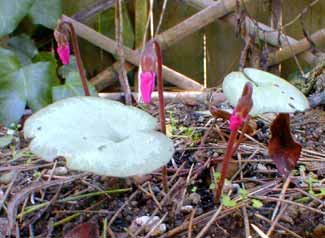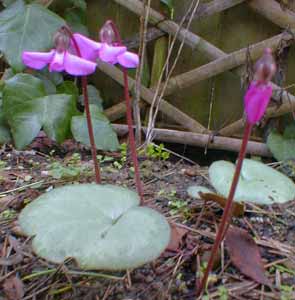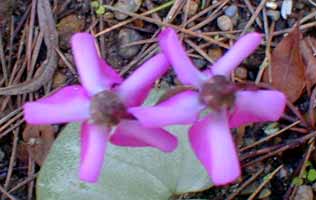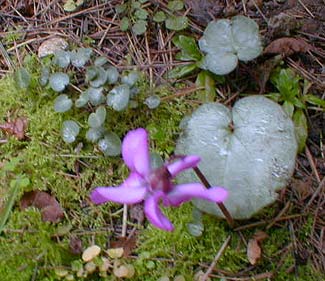
'BSBE 518'
Form 1
Pewter Cyclamen
"For a moment she standeth
Where the sea-wind softly
Moveth over
The thick pink sward of the cyclamen
blossoms."
William Sharp
1855-1905
1855-1905
From Cyclamen coum's "Pewter Group" we chose the oddly named 'BSBE 518,' which indicates a group of C. coum with entirely frosted pewter leaves, originally collected during the Bowles Scholarship Botanical Expedition along the Black Sea coast of Turkey in 1963.
 Some in this group have oval leaves uniformly silver & are called Form 1; others have an enlongated mapleleaf or christmas tree pattern at the center of the silvering, & those are Form 2. The one we obtained was of the completely silvered form, with the underside of the leaves blushed pink.
Some in this group have oval leaves uniformly silver & are called Form 1; others have an enlongated mapleleaf or christmas tree pattern at the center of the silvering, & those are Form 2. The one we obtained was of the completely silvered form, with the underside of the leaves blushed pink.The tuber does not ever need to be lifted, but will get bigger & bigger & will be more impressive for leaf & flower as each year passes. They can be planted extremely close to the base of trees while seedlings.
We planted just one of these at the very base of our Cedar of Lebanon in March 2003. This was a two-year-old seedling that was started by Ashwood Nurseries in England in Autumn 2001, & came to us via our own nearby Heronswood Nursery.
By late September 2003 it produced its first leaves in our garden. It added a leaf now & then but did not have a great many for its first or second, as it is an especially slow-growing variety.
 By October's end it had produced only a third leaf, & up through January had only a very few more leaves. It could be a couple more years before it is mature enough to become a seriously dense area of these marvelous leaves.
By October's end it had produced only a third leaf, & up through January had only a very few more leaves. It could be a couple more years before it is mature enough to become a seriously dense area of these marvelous leaves.In winter 2004/2005, it produced a great many mini-leaves such as I have never seen on any other cyclamen in our gardens. The leaves were as small as an infant's thumbnail & perfectly round! The fourth photo below shows two mature leaves, one flower, & a cluster of the tiny leaves all in the upper left hand corner of the photo. In a couple more years it should finally be a very lush clump of silvery leaves, but even at this stage, it has been fascinating.
In future years as this maturing seedling becomes a solid tuber, it will send up a great many of its round silvered leaves in mid-September, as it leafs out very early, far ahead of flowering.
 When it finally blooms about mid-January, this is a few weeks later than the majority of our C. coum varieties, but then the blooms should last longer into spring to make up for their tardy arrival. It flowers until at least early March.
When it finally blooms about mid-January, this is a few weeks later than the majority of our C. coum varieties, but then the blooms should last longer into spring to make up for their tardy arrival. It flowers until at least early March.The first photo shows the magenta buds just before mid-February. These open into flowers that are dark pink before February's end. The blooms contrast marvelously with the frosty-looking pallid sage-green leaves.
The second & third photos from 2004, & the fourth photo from 2005, are all from the third week of February, showing open flowers. Viewed from above each bloom is arranged like the spokes of a wheels, as each of five flower-petals is folded in half & looks thin from above.
The top of the "fold" of each petal is faded light pink to nearly white, but the rest of the petal is a dark pink, though not so dark a color as when still buds. The bicolor nature of the flower is as unique as the leaf form.
Care is as for other hardy cyclamens. They like to be rather dry during their summer estivation, which is one good reason to plant them near the bases of trees & shrubs, which will suck up residual water so that dormant tubers won't be too wet even in a watered garden. They're ideal for "dry shade" locations & will flourish in spots where little else wants to grow.
Continue to
Cyclamen coum 'Tilebarn Elizabeth'